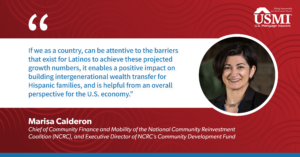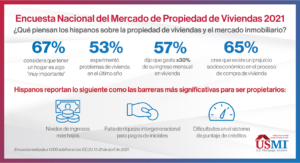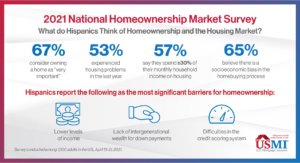
As we celebrate Hispanic Heritage Month, USMI reached out to prominent leaders in the housing finance and mortgage industries to discuss their work and perspectives on the goal of increasing Hispanic homeownership in America. In a recent blog post, USMI highlighted how the Hispanic population growth is positively impacting the homeownership market in the U.S., as the Urban Institute projects that from 2020 to 2040, most net new homeowners will be Hispanics – estimating that of the 6.9 million new homeowner households, 70 percent will be Hispanic. Further, despite having been acutely impacted by the COVID-19 pandemic, Hispanic Americans are the only demographic group to have increased their homeownership rate for six consecutive years (including 2020) according to a report by the National Association of Hispanic Real Estate Professionals (NAHREP).
These figures speak to the importance of this demographic group to our nation and the impact they will have on mortgage markets and the face of homeownership over the next several decades. This presents an opportunity for policymakers to focus on challenges minorities face when it comes to homeownership, which USMI was also able to identify in its 2021 National Homeownership Market Survey, which polled 1,000 adults in the U.S., including an oversample of Hispanic respondents. Among the obstacles Hispanics face, 66 percent indicated that the lack of affordable homes is the biggest housing-related issue. Additionally, 20 percent said that one of the biggest challenges they face when buying a home is the inability to afford a 20 percent down payment, as monthly housing costs consume a large amount of Hispanics’ income. Lastly, 65 percent of Hispanics suggested they perceive socioeconomic bias in the homebuying process, with the survey finding that lower levels of income, lack of intergenerational wealth for down payments, and difficulties in the credit scoring system are the most significant barriers for increasing minority homeownership in the U.S.
For nearly 65 years, the private mortgage insurance (MI) industry has enabled more than 35 million low- to moderate-income borrowers attain affordable and sustainable homeownership in the conventional market. In the past year alone, nearly 60 percent of borrowers who purchased their home using private MI were first-time homebuyers, and more than 40 percent had incomes of $75,000 or less. It is a goal of the MI industry to work with policymakers to increase minority lending within the conventional mortgage market, and Hispanic Heritage Month is a perfect time to advance this conversation.
Marisa Calderon, Executive Director of National Community Reinvestment Coalition’s (NCRC) Community Development Fund and a housing and financial services industry veteran, recently shared with USMI her thoughts on these issues and others, relating to the mortgage finance sector in 2021 and beyond
(1) How does Hispanic Heritage Month intersect with homeownership?
This month is about recognizing and celebrating the Hispanic community’s contributions to U.S. culture and society – and that certainly includes this population’s undeniable economic impact. Latinos have been the primary driver of homeownership growth in our nation for the past decade and will continue to be for the foreseeable future. Looking ahead to 2040, Latinos will account for 70 percent of U.S. homeownership growth. If we as a country, can be attentive to the barriers that exist for Latinos to achieve these projected growth numbers, it enables a positive impact on building intergenerational wealth transfer for Hispanic families, and is helpful from an overall perspective for the U.S. economy.
(2) In USMI’s recent 2021 National Homeownership Market Survey, nearly 7 out of 10 Hispanic respondents considered owning a home as “very important,” as it provides stability and safety. However, survey data show most Hispanics have difficulties understanding the down payment requirements and more than half see the mortgage system in need of reform. What are the top two or three housing finance priorities that lawmakers and the Biden Administration should focus on to help Hispanics achieve affordable and sustainable homeownership?
Because of the relative youth of the population, many Hispanics are first-time home buyers and are aging into their prime-homebuying years. In general, most first-time homebuyers do not fully understand whether and how much they need for a down payment; this is no different for Hispanics.
The difference is that many Hispanic households have less wealth and personal assets than their non-Hispanic White counterparts. This means they do not always have 3 or 5 percent saved for a down payment.
With that in mind, as part of the infrastructure package, lawmakers could focus on prioritizing down payment support for first-time buyers, low- to moderate-income individuals, Latinos, and other underserved communities that lack personal wealth and assets.
The second priority should be access to credit. Reevaluating how the industry looks at credit-scoring and evaluating risk for prospective homebuyers could be helpful in increasing access to homeownership, and more fairly and accurately assessing a borrower’s ability-to-repay. The mechanisms and approach used today are based on the behaviors and credit patterns of a mostly White population of borrowers from decades ago – which is very different from how today’s diverse consumers earn their income, understand, and use credit. For example, as drivers of U.S. small business growth, Hispanics are more likely to have non-W2 income as a significant or sole source of household income. They also are more likely to live in a multi-generational household where the income of other individuals contributes to household expense obligations. Factors like these, mean evaluating ability-to-repay must evolve beyond the fixed and firm nuclear family borrower that is a W2 wage earner. The method of earning income and household composition is different, not necessarily riskier.
That said, the most urgent issue to address is the critical lack of housing inventory across the country. If there are no homes to purchase, the potential to increase homeownership is invariably stymied. The Administration and lawmakers should make addressing the inventory crisis a priority and the need for affordable single-family inventory as part of its infrastructure approach. I stress this in particular because often times, a conversation about affordable housing is synonymous with affordable rentals alone. The reality is, it needs to be a yes/and approach to affordable rental and affordable single-family homes for owner occupancy, especially since homeownership is the primary way families build wealth in the U.S.
(3) As the Hispanic population in the U.S. is growing fast and it is projected to be the primary driver of net new homeowners for the next two decades, what actions or policies can promote greater racial homeownership equity in the next 5 to 10 years?
The home appraisal process is a good place to start in addressing systemic issues that contribute to building home equity for underserved communities. The disparity in increasing home values and the resulting lower home equity in historic communities of color is well documented. Addressing issues of conscious and unconscious bias in the appraisal process, as well as systemic issues that preclude a greater diversity of qualified appraisers from joining the profession, is one of the most direct actions that can be taken to address the evaluation of home value that ultimately results in equity or lack thereof.
Immigration reform is another important, often overlooked, policy area that has a direct impact on homeownership attainment. While there is nothing that precludes foreign born individuals from owning property in the United States, obtaining a mortgage as a foreign-born householder is another matter altogether. Few lenders make Individual Tax Identification Number (ITIN) loans part of their suite of products, and those that do, set terms and down payment requirements for borrowers that are frequently less favorable than those in the conventional market or Finance Housing Administration (FHA) financing, despite ITIN loans performing as well or better than traditional financing vehicles. With over 11 million undocumented individuals in the country, most of whom have resided in the U.S. for well over a decade, immigration reform with a pathway to citizenship would open traditional mortgage lending as an option to millions of potential new homeowners. Lack of status is not just a barrier to homeownership for undocumented individuals, it is an impediment to wealth building and economic mobility for millions who pay taxes, contribute to the economy, and have called the U.S. home for most of their lives.
Marisa Calderon’s Biography
Marisa Calderon is the executive director of the National Community Reinvestment Coalition’s (NCRC) Community Development Fund and a housing and financial services industry veteran.
Calderon has been ranked on the Swanepoel Power 200 as one of the most powerful leaders in the residential real estate industry and named one of HousingWire’s 2018 Women of Influence for her work in increasing real estate and mortgage professionals’ understanding and appreciation of the Hispanic home-buying market. Frequently sought out as an expert, Calderon has been interviewed by numerous publications and media outlets including NPR’s Marketplace and regularly speaks at events such as those for Mortgage Bankers Association (MBA), Consumer Federation of America (CFA), the Federal Deposit Insurance Corporation (FDIC), and the National Fair Housing Alliance (NFHA).
She previously served on the advisory board for the Banc of California and the Fannie Mae Affordable Housing Advisory Council, and previously authored the State of Hispanic Homeownership Report.
She currently serves as board secretary for the Hispanic Wealth Project, which has a stated goal of tripling the median household wealth of Hispanics by 2024. She earned her bachelor’s degree from the University of California at Berkeley and is in the process of completing her MBA.











